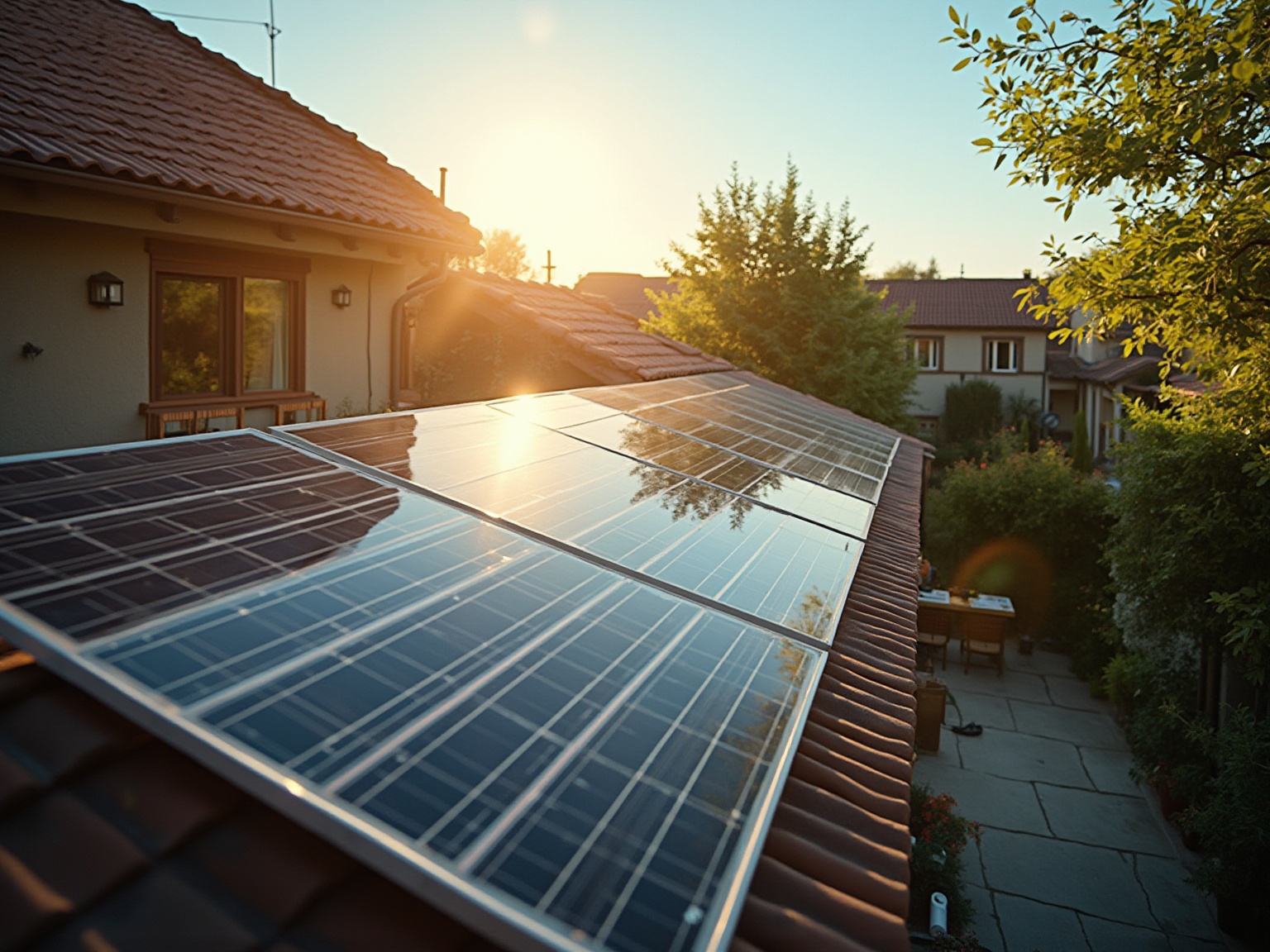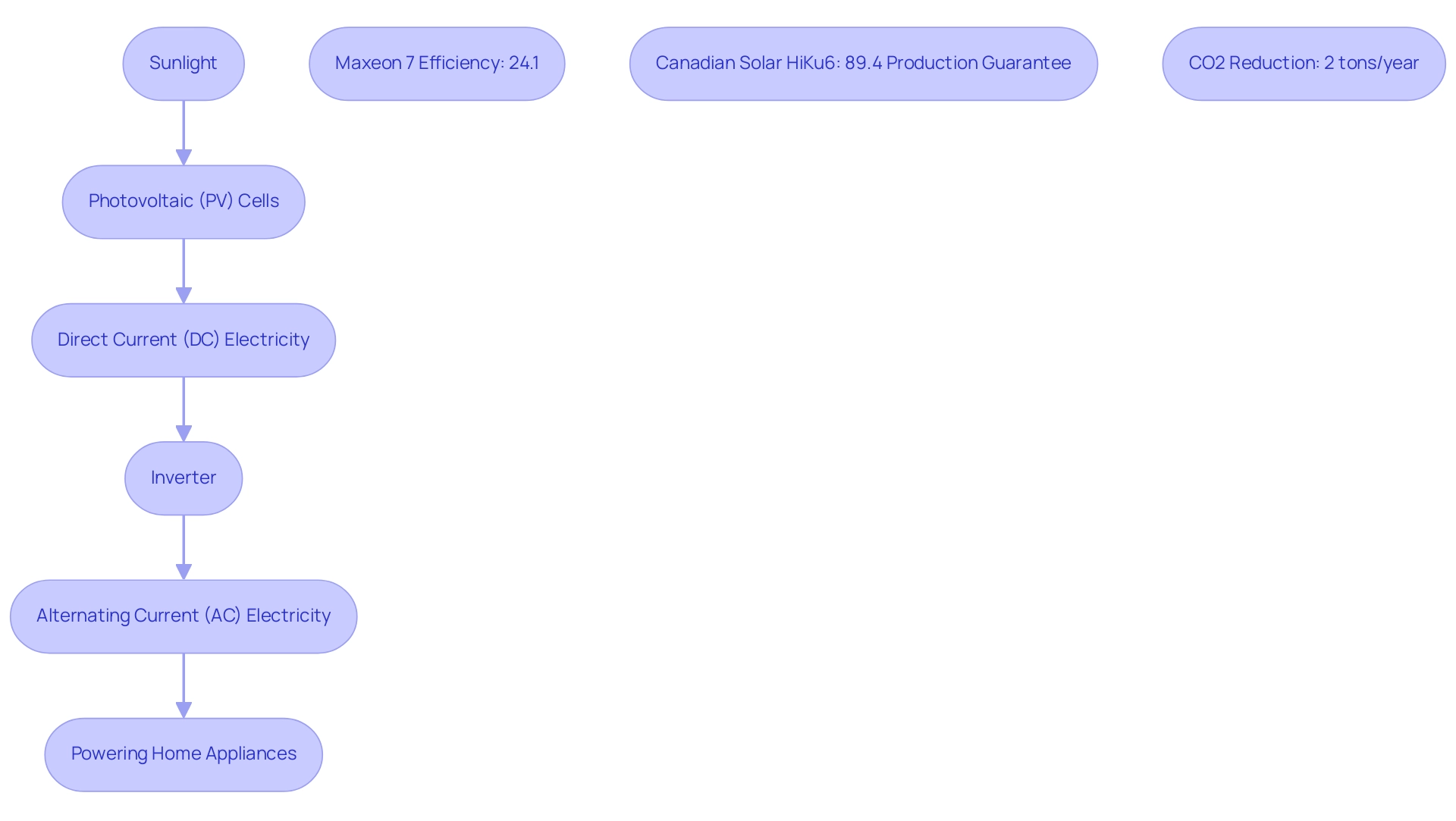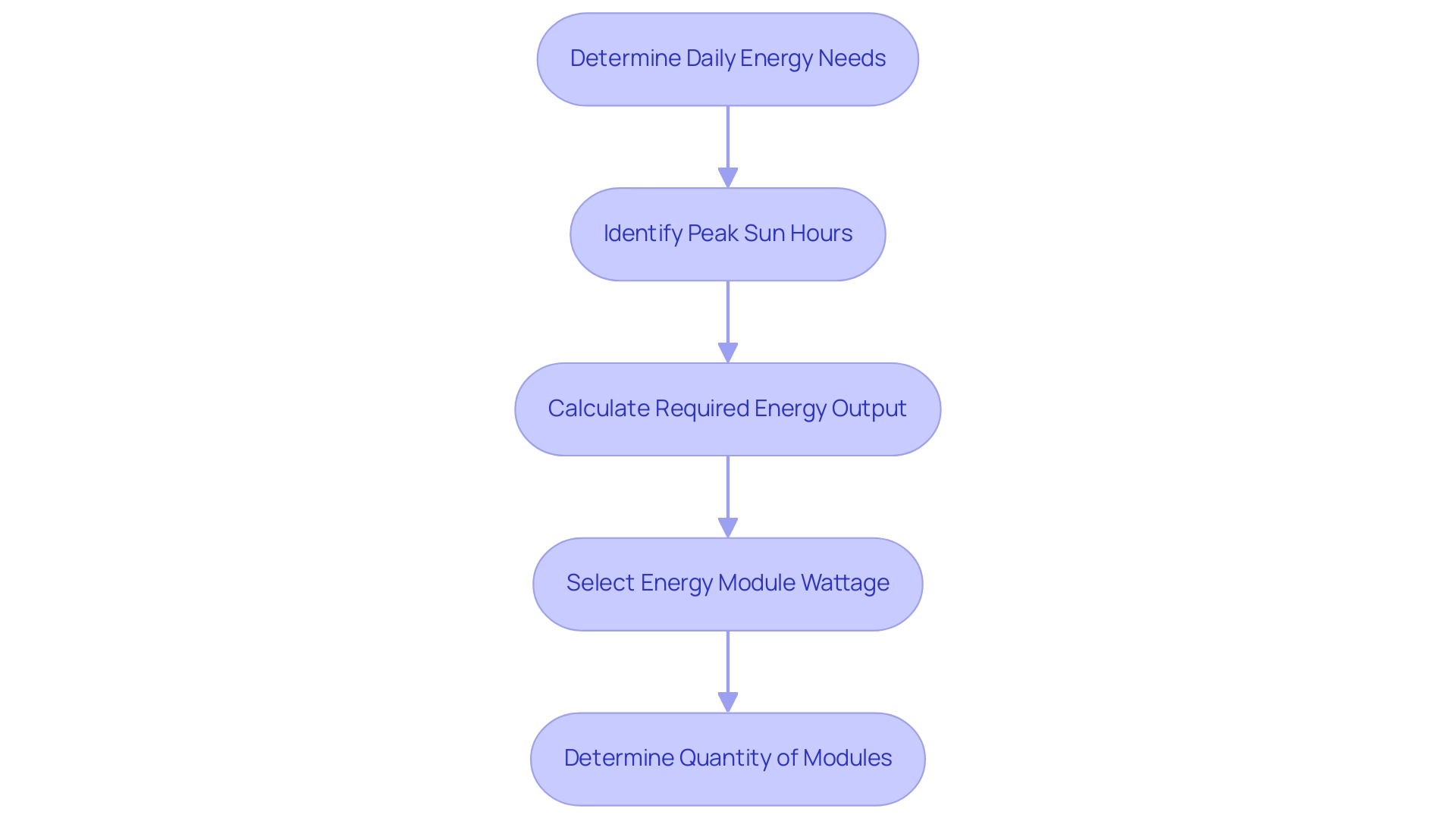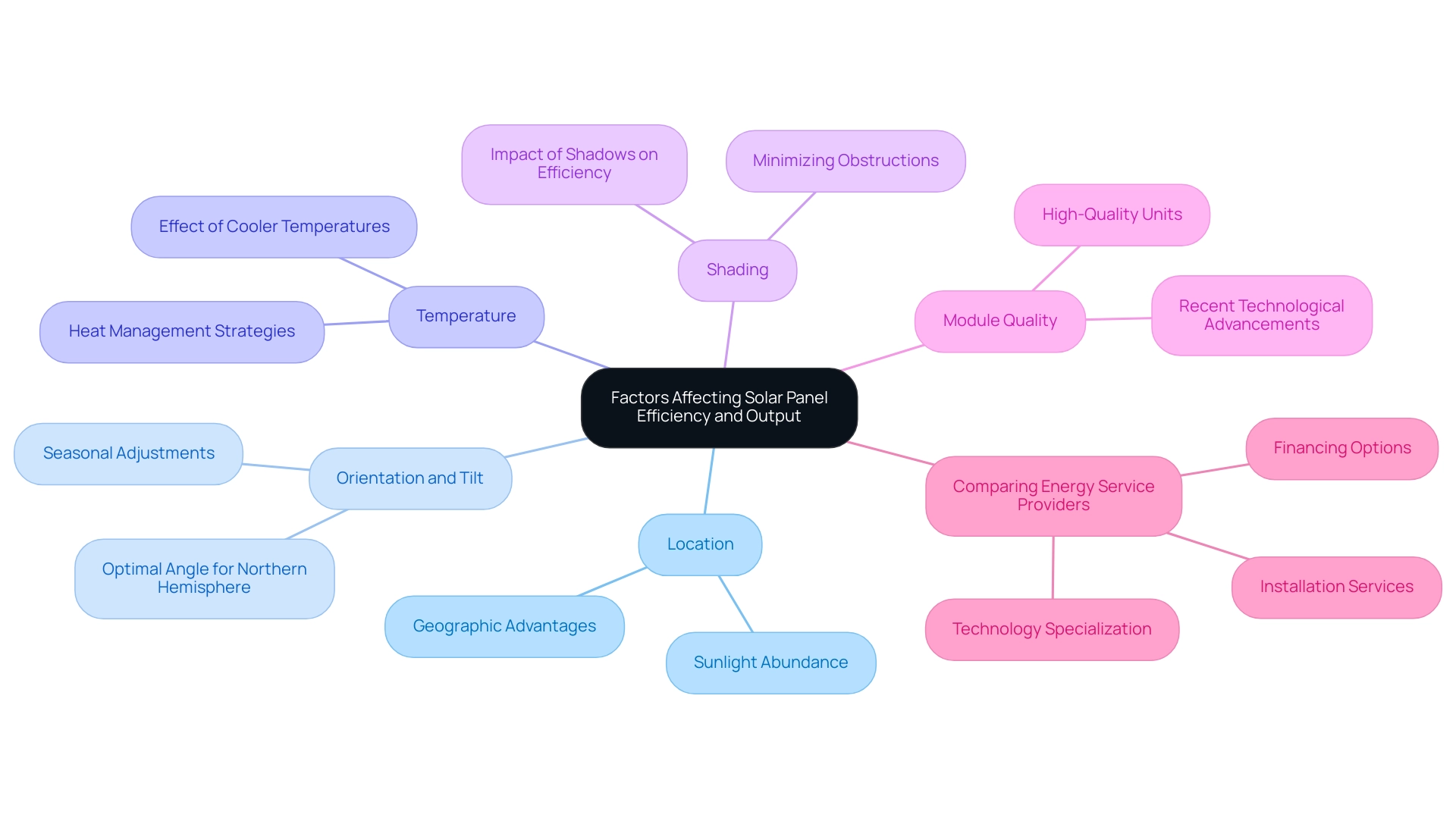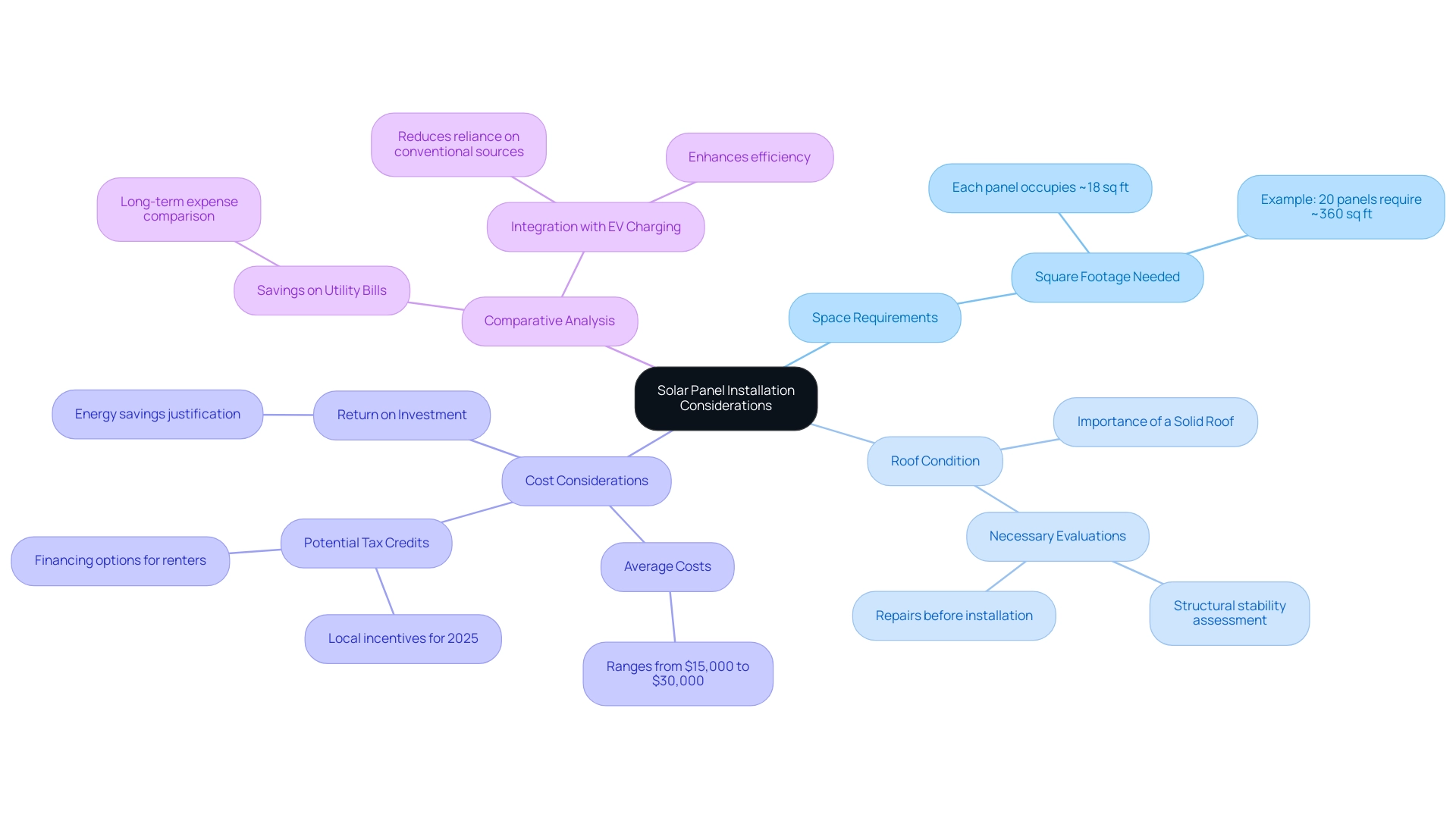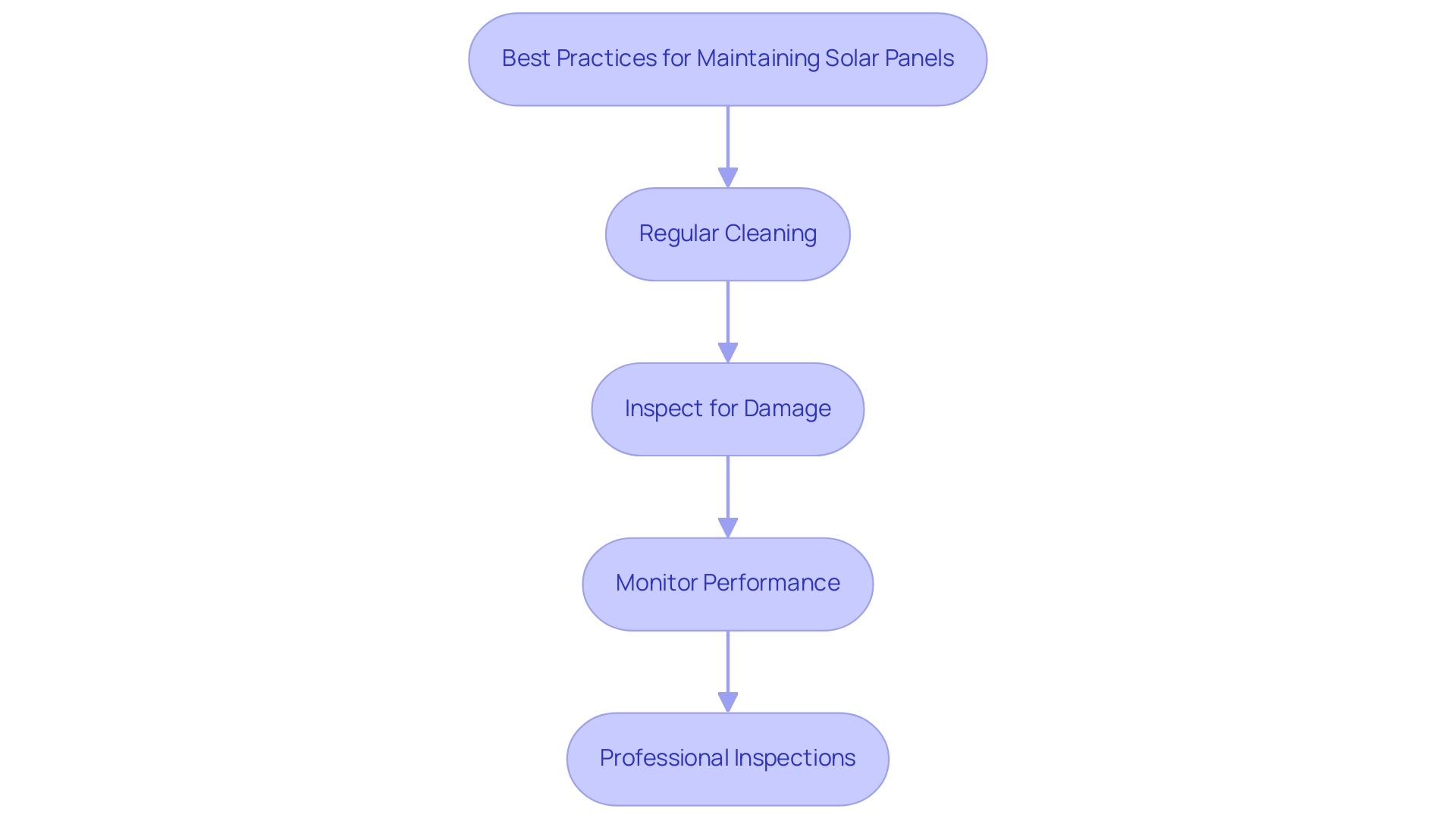Overview
This article serves as a compassionate guide for homeowners looking to understand their solar panel requirements. We know that energy bills can be a source of stress, and it’s common to feel overwhelmed by the options available. By calculating your daily energy needs and considering local peak sun hours, you can take a significant step towards energy independence. This guide details a clear methodology for determining the number of panels you may need based on your specific energy consumption.
Additionally, it’s important to consider factors like panel quality and installation, as these elements greatly influence overall efficiency. Together, we can explore how solar energy not only reduces your bills but also contributes to a sustainable future. If you’re ready to take action, we are here to support you every step of the way. Let’s work towards a brighter, more energy-efficient home together.
Introduction
In the quest for sustainable energy solutions, we understand that many homeowners are concerned about rising energy bills and the impact on their budgets. Solar panels have emerged as a beacon of innovation, transforming sunlight into a powerful source of electricity. As advancements in technology continue to reshape the solar landscape, it’s common to feel overwhelmed by the intricacies of how these systems function. However, understanding these details is vital for those eager to harness the benefits of solar energy.
From the basics of photovoltaic cells to the impact of environmental factors on efficiency, the journey into solar energy is both enlightening and essential. This article delves into the core components of solar panels, the steps to assess energy needs, and the practical considerations for installation and maintenance. Together, we can empower you to make informed decisions that align with your energy goals and contribute to a greener future.
Understanding Solar Panels: Basics and Functionality
As a homeowner, you may often find yourself worried about rising energy bills. Solar arrays offer a sophisticated solution, converting sunlight into electricity through photovoltaic (PV) cells. These cells, primarily made from semiconductor materials like silicon, generate direct current (DC) electricity when they absorb sunlight. This DC electricity is then transformed into alternating current (AC) by an inverter, making it suitable for powering your home appliances and systems.
Understanding how photovoltaic devices work is crucial for you, as it directly impacts their energy generation capabilities and efficiency in meeting your household energy needs. In 2025, advancements in photovoltaic technology have brought significant improvements in efficiency and functionality. For instance, the latest Maxeon 7 residential module boasts an impressive efficiency rating of 24.1%, surpassing competitors like Canadian Solar’s HiKu6 model, which offers a production guarantee of 89.4% over 25 years and a temperature coefficient of -0.29%.
This comparison highlights the economic advantages of investing in high-efficiency photovoltaic solutions. By choosing these systems, you could see substantial reductions in your utility bills, paving the way for a more sustainable power future.
The efficiency of photovoltaic panels isn’t just a technical specification; it has real-world implications for you as a homeowner. As solar technology evolves, the efficiency of these cells continues to improve, enabling increased power generation even in less-than-ideal conditions. Did you know that 38% of all renewable energy companies expect to grow in 2025? An additional 35% anticipate maintaining their current business levels, reflecting a robust market for these energy solutions and the growing adoption of sustainable practices that help reduce greenhouse gas emissions.
Moreover, solar-powered water heating systems can save you between $400 to $600 annually on utility costs, emphasizing the financial benefits of renewable technology. It’s also important to note that the effectiveness of photovoltaic panels is influenced by several factors, including the quality of the inverter used. Inverters can produce sound levels ranging from 40 to 70 dBA, while transformers may reach 50 to 80 dBA, depending on their size and type. We understand that noise levels can impact the comfort of your living environment, making this an essential consideration when installing photovoltaic systems.
In terms of environmental impact, utilizing solar heating systems can prevent 2 tons of carbon dioxide from entering the atmosphere each year—equivalent to not driving a vehicle for four months. This statistic underscores the vital role that renewable energy technology plays in promoting sustainability. In summary, the ability of photovoltaic systems to convert sunlight into electricity is a blend of advanced technology and practical application.
By learning how to calculate your solar panel requirements and understanding how these systems operate, along with the advancements made in 2025, you can make informed decisions about your energy needs. Together, we can explore the potential advantages of renewable resources, including cost savings, enhanced independence, and a commitment to fostering environmental sustainability.
Assessing Your Energy Needs: The First Step in Calculation
To correctly evaluate your power requirements for a photovoltaic setup, we understand that reviewing your electricity statements from the previous year is a great starting point. This practice will help you determine your average monthly kilowatt-hour (kWh) usage. For instance, if your monthly usage totals 600 kWh, you can easily calculate your daily consumption by dividing this figure by 30, resulting in a daily usage of 20 kWh.
This daily usage statistic is vital for understanding how to calculate the solar panel requirement needed to meet your power needs.
In California, the typical household electricity consumption in 2025 is anticipated to be approximately 600 kWh monthly, reflecting a growing inclination towards efficiency and sustainability. Long Beach tenants can benefit from various eco-friendly power solutions, including Tesla home chargers and government initiatives that promote renewable energy adoption. Significantly, regions such as Alaska and Florida have seen a reduction in electricity costs, highlighting the possible financial advantages of shifting to renewable sources.
Grasping your particular electricity requirements is crucial, as it helps you learn how to calculate the solar panel requirement to customize your photovoltaic system to your household’s needs. To enhance your calculations, consider elements such as seasonal fluctuations in power usage and the effectiveness of the modules you intend to install. For example, it’s common to feel that if you expect heightened power consumption during the summer due to air conditioning, you might need to adjust your calculations accordingly.
Many homeowners have effectively determined their power usage for renewable systems by utilizing online tools or seeking advice from specialists. For example, a household in Roseville recently evaluated their power requirements and discovered that by installing a photovoltaic setup capable of generating 25 kWh daily, they could significantly lessen their dependence on the grid and reduce their electricity expenses. Powercore Electric’s internal team of specialists guarantees top-notch installations and upkeep, providing the support you need to facilitate this transition seamlessly.
To comprehend how photovoltaic systems function, they transform sunlight into electricity via photovoltaic cells, which can then be utilized to energize your residence or stored in batteries for future use. By following these steps, you can ensure that your photovoltaic system is not only efficient but also tailored to meet your specific power requirements. This understanding is essential for calculating the solar panel requirement, paving the way for a more sustainable and economical power solution. Moreover, with California’s limited coal production and the state’s ongoing investment in renewable initiatives, shifting to alternative sources is not just a personal advantage; it’s a contribution to a broader movement towards sustainable practices.
Explore the benefits and drawbacks of photovoltaic shingles, which can provide aesthetic and space-saving advantages. Consider optimal battery choices for energy storage to enhance your renewable experience. Additionally, sunlight heating systems can offer economic and environmental benefits, such as reducing heating costs and lowering carbon footprints, making them a valuable consideration for homeowners.
Calculating Solar Panel Requirements: Step-by-Step Methodology
To accurately determine the number of photovoltaic panels required for your home, we invite you to follow this comprehensive step-by-step guide:
- Determine Daily Energy Needs: Start by calculating your daily consumption. For instance, if your household requires 20 kWh per day, this figure will serve as your baseline.
- Identify Peak Sun Hours: Research the average peak sun hours specific to your location. In California, homeowners can typically expect around 5 peak sun hours per day, which is essential for your calculations.
- Calculate Required Energy Output: To find out how much sunlight energy you need to generate, divide your daily energy needs by the peak sun hours. For example, using the earlier figure: 20 kWh / 5 hours = 4 kW.
- Select Energy Module Wattage: Choose the wattage of the energy modules you plan to install. If you choose 300W modules, convert this to kilowatts (300W = 0.3 kW).
- Determine Quantity of Modules: Ultimately, divide the necessary energy output by the wattage of the modules. Continuing with our example: 4 kW / 0.3 kW = approximately 13.33. Therefore, you would require approximately 14 photovoltaic modules to meet your power demands.
This approach not only assists you in grasping your renewable needs but also teaches you how to calculate the solar panel requirement for making knowledgeable choices regarding your power usage and sustainability initiatives. By utilizing the right technology, such as optimal battery selections for efficient power storage and understanding the advantages of home photovoltaic system sizes under the 200% rule, you can effectively transition to renewable resources. For homeowners in areas with fewer peak sun hours, technologies like bifacial panels can enhance efficiency by capturing reflected light.
Case Study Insight: For example, homeowners who implemented photovoltaic systems under the 200% rule have reported significant savings on their utility bills, enabling them to reinvest in home enhancements. Furthermore, choosing top-notch batteries, like the Tesla Powerwall or LG Chem, can enhance storage and usage efficiency. With more than 30 years of experience, Powercore Electric Inc. highlights community engagement and openness, guaranteeing you receive top-notch service and assistance as you begin your journey into renewable energy.
Factors Affecting Solar Panel Efficiency and Output
As environmentally conscious homeowners, you may be wondering how to optimize the effectiveness and production of photovoltaic systems. Here are several essential elements to consider:
- Location: The geographic position of your home plays a crucial role in the generation of renewable resources. Areas blessed with abundant sunlight naturally yield greater output. For instance, regions in California benefit from a favorable climate that enhances photovoltaic performance, making them ideal for renewable energy installations. This not only boosts your power autonomy but also reflects the growing recognition of photovoltaic advantages, including cost savings and a reduction in greenhouse gases.
- Orientation and Tilt: The angle at which photovoltaic modules are installed can significantly influence their efficiency. In the Northern Hemisphere, it’s best for solar structures to face true south to capture the maximum sunlight throughout the day. Adjusting the tilt angle according to seasonal variations can further enhance power generation, supporting your sustainability initiatives.
- Temperature: Interestingly, photovoltaic systems operate more effectively in cooler temperatures. While it may seem counterintuitive, excessive heat can diminish output. Thus, in warmer regions, careful planning of module placement and airflow is essential to maintain peak efficiency, enhancing your investment in renewable energy.
- Shading: The presence of trees, buildings, or other obstacles can cast shadows on energy collection devices, significantly reducing their effectiveness. To maximize energy production, it’s vital to install modules in areas with minimal shading throughout the day, reinforcing your commitment to clean energy practices.
- Module Quality: The type and quality of photovoltaic modules are also critical to their efficiency. Higher-quality units typically provide better performance and longer warranties, offering peace of mind regarding your investment. Recent advancements in photovoltaic technology have led to the development of panels that bridge the gap between laboratory efficiencies and real-world applications, promising improved performance for residential setups. These innovations not only promise higher efficiency rates but also contribute to job creation in the renewable sector.
- Comparing Energy Service Providers: When choosing an energy service provider, it’s essential to evaluate their offerings thoughtfully. Some companies may provide comprehensive installation services and maintenance plans, while others might specialize in financing options or cutting-edge technology. Assessing these factors can help you identify which provider delivers the best value for your specific needs, ensuring you make a well-informed choice.
While photovoltaic installations significantly reduce emissions, they also present environmental challenges, such as impacts on biodiversity and resource usage. Understanding these elements is vital for homeowners looking to optimize their photovoltaic setups while participating in initiatives like the Biden-Harris administration’s Solar for All, which advocates for equitable access to renewable power. Additionally, heating systems can protect homeowners from fluctuations in power costs, providing a consistent and predictable utility expense.
By thoughtfully considering location, installation specifics, and module quality, you can greatly enhance the efficiency and output of your photovoltaic systems. Together, we can ensure a sustainable energy solution that aligns with both your economic and environmental goals.
Evaluating Installation Requirements: Space and Cost Considerations
When contemplating solar panel installation, we understand that eco-conscious homeowners are often faced with several critical factors that can influence their decision:
-
Space Requirements: Each solar panel generally occupies approximately 18 square feet. To determine how to calculate the solar panel requirement, multiply the number of units you plan to install by this figure. For instance, if you require 20 units, you will need around 360 square feet of roof space, a crucial consideration for maximizing energy output.
-
Roof Condition: It’s common to feel uncertain about your roof’s condition. A thorough evaluation is vital; it must be structurally stable and able to bear the weight of the energy collectors. If your roof shows signs of wear or damage, it’s advisable to undertake necessary repairs before proceeding with the installation. Experts recommend carrying out a roof assessment to confirm it satisfies the criteria for energy system support. As Michael Tobias, Founding Principal of NY Engineers, emphasizes, “A solid roof is crucial for the longevity and effectiveness of photovoltaic installations.”
-
Cost Considerations: In California, the average cost of a solar panel system ranges from $15,000 to $30,000, influenced by factors such as the size of the system and the type of panels selected. Homeowners should explore available tax credits and incentives, which can significantly lower the overall expense. For 2025, local incentives and financing options improve affordability, especially for renters in Long Beach seeking to transition to eco-friendly power solutions. Understanding the potential return on investment through energy savings can help justify the initial costs. Notably, the renewable energy sector saw 1.1 GW of residential installations in Q3 2024, reflecting a growing trend despite recent uncertainties. Homeowners should stay informed about these market dynamics and consider state incentives and support when assessing panel installation.
-
Comparative Analysis: When assessing renewable power options, consider the long-term expenses related to conventional electricity. Solar power can result in significant savings on monthly utility bills, especially as electricity rates keep increasing. Additionally, integrating solar panels with EV charging solutions can further enhance efficiency and reduce reliance on conventional sources, providing both economic and environmental advantages.
By carefully evaluating these aspects, homeowners can understand how to calculate the solar panel requirement, enabling them to make informed decisions that align with their power requirements and financial goals. Together with the expertise of Powercore Electric’s in-house team, you can ensure high-quality installations and maintenance. This holistic approach not only encourages efficiency but also contributes to long-term sustainability and environmental stewardship.
Maintaining Your Solar Panels: Best Practices for Longevity
To maintain your solar panels effectively, consider the following best practices:
- Regular Cleaning: We understand that keeping your panels clean is vital for optimal performance. Aim to clean your panels at least twice a year to eliminate dust, debris, and bird droppings that can obstruct sunlight. For safe cleaning, use a low-pressure hose and a soft brush with mild soap and water, avoiding pressure washers that can cause damage. Regular maintenance is essential, as even slight performance declines can build up over time, making proactive care crucial for efficiency and sustainability. Research from the Indian Institute of Engineering Science and Technology highlights that dust accumulation can significantly impact power production, emphasizing the need for regular cleaning.
- Inspect for Damage: It’s common to feel concerned about the integrity of your solar setup. Conduct regular inspections for any physical damage or loose connections. If you identify any issues, it’s crucial to contact a professional for timely repairs to prevent further complications. Powercore Electric proudly provides expert inspections, ensuring your setup remains in top condition.
- Monitor Performance: Keeping a close watch on your energy production can feel daunting, but it’s important. A significant drop in output may indicate underlying problems that require immediate attention. Regular performance monitoring can help you catch issues early and prevent costly repairs. Data indicates that the median loss rate for photovoltaic installations is 0.75% annually, with 90% of units experiencing less than a 2% loss each year, emphasizing the significance of monitoring.
- Professional Inspections: Arranging a professional examination every few years can provide peace of mind. These inspections can help identify potential issues before they escalate, protecting your investment. Powercore Electric, with more than 30 years of experience serving California, is dedicated to providing outstanding service and support to our community, ensuring your renewable power system is maintained efficiently.
By following these maintenance practices, homeowners can enhance the efficiency and longevity of their energy collectors, contributing to a sustainable energy future. As the renewable energy sector continues to grow, with over 30 GW installed as of Q3 2024, maintaining your panels becomes increasingly important. Neglecting maintenance can lead to decreased efficiency and higher costs in the long run.
As Ben Zientara, a policy analyst in renewable energy, observes, “Given the concerns outlined by energy companies in response to our survey, it appears that some of the industry’s worst fears are about to come true.” This underscores the necessity for proactive maintenance to ensure your energy investment remains effective. With Powercore Electric’s focus on customer-first service and local expertise, we are here to support you in maintaining your solar energy system.
Conclusion
Understanding solar energy is vital for homeowners concerned about rising energy costs and eager to contribute to a more sustainable environment. We recognize that navigating these choices can feel overwhelming, but this article has illuminated the essential workings of solar panels, highlighting the significance of photovoltaic cells and the exciting advancements in technology that boost efficiency. By thoughtfully assessing your energy needs and calculating the number of panels required, you can customize solar solutions that align with your specific consumption patterns, maximizing both your savings and your energy independence.
Moreover, it’s important to consider various factors such as location, panel orientation, temperature, and shading, all of which can significantly impact the efficiency of your solar system. By carefully evaluating these elements, you can optimize your installation for enhanced performance and longevity. We understand that installation requirements, including space and cost, are crucial considerations, and ensuring a smooth transition to solar energy is essential for your peace of mind.
Maintenance is also a key aspect of reaping the long-term benefits of solar panels. Regular cleaning, inspections, and performance monitoring are vital practices that help maintain efficiency and extend the lifespan of your system. As the solar industry continues to evolve, we encourage you to stay informed about market trends, incentives, and technological advancements that can enrich your solar experience.
In conclusion, embracing solar energy is not just a personal gain; it is a heartfelt commitment to a sustainable future. By delving into the intricacies of solar technology and making informed choices, you can significantly influence your energy costs and environmental footprint, paving the way for a greener tomorrow. Together, let’s work towards a brighter, more sustainable future.


